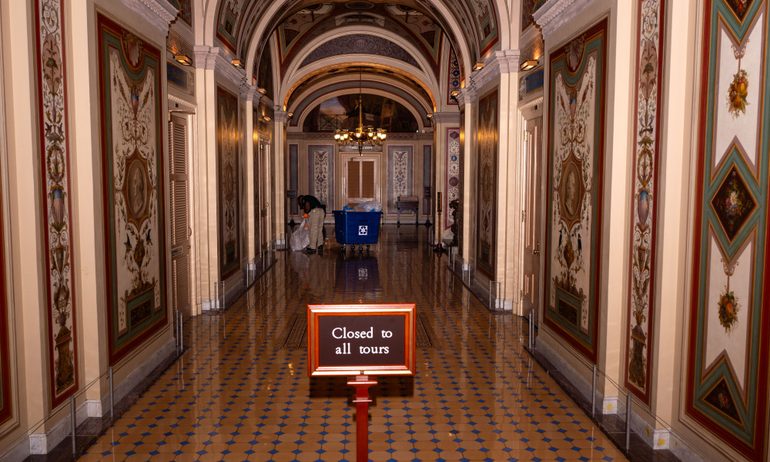House Speaker: Shutdown ‘Could Be One of the Longest’ Ever
Most federal employees are furloughed or working without pay as the shutdown enters its third week.

Many, or all, of the products featured on this page are from our advertising partners who compensate us when you take certain actions on our website or click to take an action on their website. However, this does not influence our evaluations. Our opinions are our own. Here is a list of our partners and here's how we make money.
Updated on Oct. 15.
The U.S. government shutdown enters its third week with no immediate sign of a breakthrough in the partisan deadlock.
The Senate on Tuesday failed for the eighth time to pass a GOP-backed funding stopgap to end the shutdown, which began Oct. 1.
“We’re barreling toward one of the longest shutdowns in American history,” House speaker Mike Johnson warned on Monday, and he again called on Democrats to line up behind the GOP’s funding stopgap proposal.
That bill, and a rival measure from Democrats, had already been voted on — and rejected — multiple times. The Democrat-backed measure was not voted on Tuesday.
Both bills were first rejected by the Senate on Sept. 30, triggering the shutdown. One stopgap had already passed the House and was backed by Republicans, while an alternative resolution proposed by Democrats sought concessions on health care spending. Both failed to meet the 60-vote bar needed for passage.
Shutdown: What happens now?
For starters, nonessential services have shut down, putting many thousands of federal workers on furlough while all other essential staff continue to report without pay. It also means delays for certain benefit program features, financial aid and IRS verification, as well as potential travel disruptions.
As the shutdown enters its third week, federal workers have started to receive partial paychecks for work through Sept. 30. Most will not be paid again until funding is restored. Typically, workers receive back pay for the time missed during a shutdown, a practice codified in 2019 under the bipartisan Government Employee Fair Treatment Act. However, the White House budget office last week issued a memorandum challenging the guarantee of backpay.
The White House has found ways to pay members of the military and the FBI, at least for now, but other areas of the federal workforce will continue to be furloughed or forced to work without pay.
Last week, the White House began the layoff of government employees that it had threatened in the event of a shutdown. Notices went out to at least 4,100 workers in seven departments, according to an initial court filing on Friday, and officials signalled further cuts.
On Wednesday, however, a federal judge temporarily blocked the layoffs.
Air travelers are already feeling the effects of the shutdown. Last week, the Federal Aviation Administration reported air traffic controller shortages that led to delays at major airports, including Hollywood Burbank Airport in California, Newark Liberty International Airport in New Jersey and Denver International Airport in Colorado.
Why did the government shut down?
Every year, Congress is supposed to pass 12 spending bills to keep the government’s lights on. These appropriations bills fund those programs already approved by Congress, including defense, the IRS, food assistance, veterans’ benefits and national parks.
The deadline to fund programs for the next fiscal year — in this case 2025-2026 — is always Oct. 1. Without passing appropriations bills or approving a stopgap that kicks the deadline down the road, the government shuts down.
Why didn’t Congress pass the funding bills? The two parties are deadlocked over Democrats’ demands to permanently extend expiring Obamacare subsidies and roll back recent Medicaid cuts in the “one, big beautiful bill.”
In the past few funding cycles, Congress has relied on multiple short-term continuing resolutions to keep the government temporarily running. So far none of the stopgap bills introduced in the Senate have been approved.
On Sept. 29, congressional leaders from both parties met with President Donald Trump to negotiate, but failed to make any progress on the impasse.
How long will the government shutdown last?
It’s unclear how long this shutdown will last. There have been 21 shutdowns since 1976 and most are short-lived — a few hours or days, at the most.
There hasn’t been a shutdown since the 2018-2019 shutdown — the longest in history — which lasted 35 days. The reason for that shutdown was a dispute over funding for Trump’s border wall in his first term.
Before that there was a 16-day shutdown in 2013 as negotiations over the Affordable Care Act dragged on. In 1995 and 1996, two shutdowns totaled 26 days.
What happens when the government shuts down?
Federal workers will bear the brunt of the shutdown’s impact. And there could be more bad news for federal workers on the way. Last week, the Office of Management and Budget issued a memo directing agencies to consider mass firings during a shutdown. Furloughs are standard during shutdowns, but it’s unclear if a funding lapse can legally justify permanent layoffs.
During the shutdown, there will be ripple effects on delivery of government services and programs.
What’s affected immediately:
National parks may close or operate without services.
Federal student aid application processing could be delayed. The shutdown coincides with the opening of the Free Application for Federal Student Aid (FAFSA).
Food and drug inspections will be delayed.
The IRS can’t verify income and Social Security numbers, which could cause delays for some mortgages and other loan approvals, as well as tax refunds.
What will keep running, to a point:
Flights will still operate, but there could be delays if TSA agents and air traffic controllers, who are considered essential employees, decide to call out of work, leading to staff shortages. Even small shortages can have a big impact: During a 2019 government shutdown, the absence of just 10 air traffic controllers at two airports grounded flights and caused delays for the Eastern Seaboard. (Read more on how the shutdown affects travel.)
Social Security and Medicare will keep going, but some administrative functions may be suspended, and telehealth appointments may be interrupted.
Unemployment benefits will continue — states administer compensation — but there could be application processing delays if the shutdown lasts long enough.
Food benefits through Supplemental Nutrition Assistance Program (SNAP) and the accompanying WIC program will continue — both run on contingency funds. WIC funding will only last one month, and SNAP could be strained after 30 days, as well.
What won’t be affected:
The postal service — the USPS is not funded by the federal government.
Federal student loan payments — accounts are serviced by private companies.
Public schools will remain open — they’re funded by state and local governments.
Amtrak will continue operations — it is operated by a for-profit company.
See more details on how a government shutdown could impact you.
The shutdown could have trickle-down economic effects, depending on how long it continues. But one immediate and direct impact will be a suspension of federal economic data. That data won’t be released during the shutdown, including the monthly jobs report that was scheduled for Oct. 3 and the Bureau of Labor Statistics would also halt data collection. That’s a problem because the government’s official data releases guide the markets, the Federal Reserve and business decisions.
The BLS did announce Friday that the September consumer price index report would be issued, although it will be released on Oct. 24 rather than the scheduled date of Oct. 15.
For more on the effects of a government shutdown, listen to our Smart Money podcast episode from Sept. 25.
(Photo by Kent Nishimura/Getty Images)
ON THIS PAGE
ON THIS PAGE






